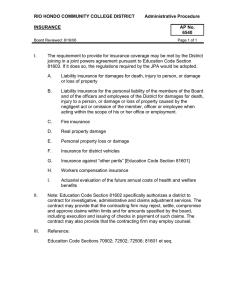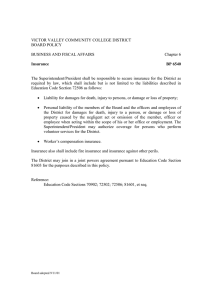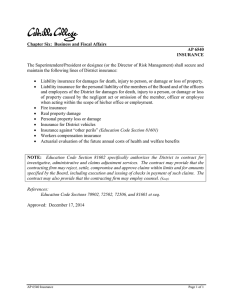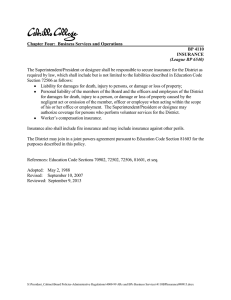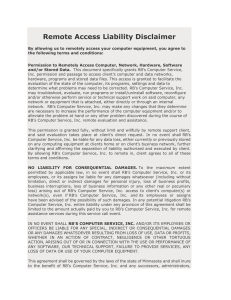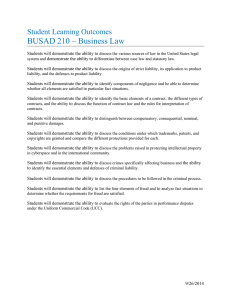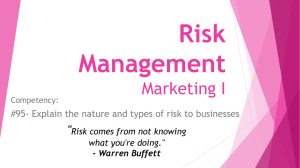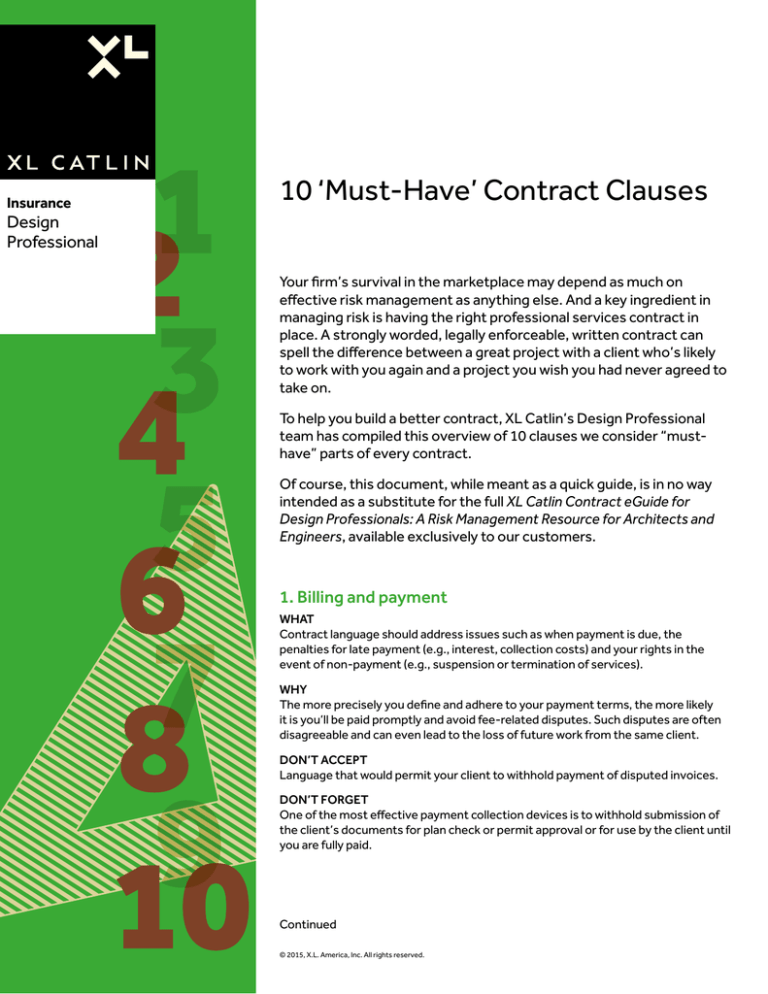
Insurance
10 ‘Must-Have’ Contract Clauses
Design
Professional
Your firm’s survival in the marketplace may depend as much on
effective risk management as anything else. And a key ingredient in
managing risk is having the right professional services contract in
place. A strongly worded, legally enforceable, written contract can
spell the difference between a great project with a client who’s likely
to work with you again and a project you wish you had never agreed to
take on.
To help you build a better contract, XL Catlin’s Design Professional
team has compiled this overview of 10 clauses we consider “musthave” parts of every contract.
Of course, this document, while meant as a quick guide, is in no way
intended as a substitute for the full XL Catlin Contract eGuide for
Design Professionals: A Risk Management Resource for Architects and
Engineers, available exclusively to our customers.
1. Billing and payment
WHAT
Contract language should address issues such as when payment is due, the
penalties for late payment (e.g., interest, collection costs) and your rights in the
event of non-payment (e.g., suspension or termination of services).
WHY
The more precisely you define and adhere to your payment terms, the more likely
it is you’ll be paid promptly and avoid fee-related disputes. Such disputes are often
disagreeable and can even lead to the loss of future work from the same client.
DON’T ACCEPT
Language that would permit your client to withhold payment of disputed invoices.
DON’T FORGET
One of the most effective payment collection devices is to withhold submission of
the client’s documents for plan check or permit approval or for use by the client until
you are fully paid.
Continued
© 2015, X.L. America, Inc. All rights reserved.
10 ‘Must-Have’ Contract Clauses • 2
2. Certifications, guarantees and
warranties
WHAT
Your contract should never promise to assure the total
accuracy of something (e.g., a subcontractor’s HVAC
installation) or confirm absolute compliance with a standard
(e.g., ADA compliance).
WHY
By certifying, guaranteeing or warranting something, you are
assuming a level of liability well beyond the legally required
standard of care. Your professional liability insurance is
not intended to cover breach of contract or warranty, the
assumption of someone else’s liability or a promise to
perform to a standard of care higher than legally required. The
smallest error, whether caused by you or someone else, could
lead to a claim of breach of warranty.
DON’T ACCEPT
Other terms that, in effect, guarantee, such as “all,” “every,”
“insure,” “ensure,” “assure,” “state” or “declare.”
DON’T FORGET
• You can substitute contract language that reduces your
risk, doesn’t jeopardize your professional liability insurance
coverage and answers your client’s concerns.
• Certifications, warranties and guarantees may also be
found in the fine print of a client’s purchase orders.
3. Consequential damages
WHAT
Your contract should include a Waiver for Consequential
Damages, those indirect expenses (e.g., loss of profit) that
are remotely connected to a design professional’s failure. This
should include a provision that makes it clear that neither
you nor your client will be held responsible for consequential
damages because of any alleged failures by either party.
WHY
If you are to be held responsible for consequential damages,
you could be sued for damages totally out of proportion to
your fee or grossly exceeding the cost of repairing the actual
damage.
DON’T ACCEPT
Any language in a client-drafted contract that would make
you responsible for consequential damages.
DON’T FORGET
• If your contract remains silent about consequential
damages, you can still be sued for them.
• Having a negotiated limit of liability does not take the
place of the additional protection against liability for
consequential damages. Be sure your Limitation of Liability
and Consequential Damages clauses are coordinated with
each other.
© 2015, X.L. America, Inc. All rights reserved.
4. Jobsite safety
WHAT
Your contract should include a Jobsite Safety provision
that makes clear that responsibility for site safety and
construction means and methods remains with the
contractor, not the design professional.
WHY
Assuming any responsibility for safety programs and safety
procedures, either by contract or by your actions, can have
serious economic consequences.
DON’T ACCEPT
Any language that calls for your “supervision” on a jobsite, or
any extreme contract language that calls for you to “assure
strict compliance” with plans and specifications or to provide
services beyond the traditional standard of care. Delete any
client-provided contract clause that gives you control or
charge of the contractor, including the authority to stop work.
DON’T FORGET
• What you say and do during the project could change the
terms of the contract.
• You cannot ignore your duty as a licensed professional
to step forward in the face of imminent threats to life or
safety about which you are aware, contractual language of
exoneration notwithstanding.
5. Limitation of Liability (LOL)
WHAT
Include in your contract a Limitation of Liability clause, an
agreement between you and the client to establish the
maximum liability you will be responsible for if there is a claim
by the client on the project.
WHY
Any professional firm that continually accepts unlimited
project risks can eventually expect huge losses and, perhaps,
financial disaster. An LoL allocates a project’s risk in some
reasonable proportion to the profits and other benefits to be
derived by each party.
DON’T ACCEPT
As a general rule, any contract without an LoL. (Some
exceptions are projects for public entities, which almost
never agree to an LoL.) Also, don’t use a preprinted liability
cap in your agreement, as it may weaken the premise that the
clause was negotiated.
DON’T FORGET
• You may have more success in obtaining a Limitation of
Liability from your client if you use a preprinted form that
contains an LoL provision with a blank space you can use to
specify the liability cap.
• Be sure to select a limit that is meaningful (e.g., an amount
tied to your project fees) and takes into account potential
damages on a project.
10 ‘Must-Have’ Contract Clauses • 3
6. Mediation
8. Standard of care
WHAT
Mediation is an approach to dispute resolution, typically
voluntary, that helps disputing parties reach agreement
among themselves, thus maintaining or reopening their
communications. Your contract should include a clause that
calls for mediation as the first step in settling disputes.
WHAT
Your contract should include a clause that affirmatively
defines the standard of care to which you will perform. The
standard of care for design professionals requires only that
you perform your services with the degree of skill and care
ordinarily exercised by other members of your profession
under similar circumstances, at the same time and in the
same or a similar locale.
WHY
Litigation and arbitration proceedings can be both expensive
and time consuming, cutting into a firm’s billable hours,
hurting morale and lowering productivity. These adversarial
processes can also destroy client-consultant relationships.
DON’T ACCEPT
A contract that doesn’t call for mediation as the first step
in dispute resolution. Otherwise, you’ll have a difficult time
convincing a client to use mediation when the two of you are
in the middle of a dispute.
DON’T FORGET
Mediation has a remarkable track record, especially when
employed at the appropriate stage of the dispute. The
average rate of settlement in mediated cases is nearly 85
percent.1
7. Scope of services
WHAT
The scope of services is a detailed description of those
services you will provide to the client, those you can provide
for an additional fee and those you will not provide. It should
be as precise and complete as possible. It should leave no
ambiguity or question as to whether or not some duty or
deliverable item is included within your basic fee.
WHY
Unless your scope is carefully defined, you may not be
able to differentiate included services from extra services
not contemplated in your basic fee. This makes it difficult
to charge for any additional services you are required to
perform.
DON’T ACCEPT
Any client-drafted clauses that ask you to agree (or even
certify) that the scope of services proposed will be “adequate
to meet the project needs,” that you will “provide any and
all professional services necessary for completion of the
project” or similar sweeping language.
DON’T FORGET
Detailed checklists of all potential services can help you avoid
overlooking scope items. You can use the scope of services
lists in the AIA, EJCDC or other professional association
agreements.
A Guide to Mediation and Arbitration for Business People (New York: American Arbitration Association)
1
© 2015, X.L. America, Inc. All rights reserved.
WHY
Any contract language that seeks to raise your standard of
care increases your risk. Your professional liability insurance
will not cover you for this increased exposure, since it
represents an assumption of additional liability for which you
would not otherwise be responsible.
DON’T ACCEPT
A client’s contract language that requires you to “perform
to the highest standard of practice.” Nor should you accept
broad or ambiguous language such as “appropriate” or
“necessary,” or provisions that would have the client making
a unilateral determination as to the performance of your
services, such as “to the satisfaction of the Client,” or “in the
Client’s sole judgment.”
DON’T FORGET
Nowhere in the Standard of Care doctrine or definition is
there any mention of “perfection.”
9. Termination
WHAT
Your contract should include a termination clause that defines
the circumstances (e.g., nonpayment of fees) under which
either party may end its legal relationship and, depending on
who initiates the action, specify the rights that each party has
when the termination occurs.
WHY
A contract that does not adequately address the subject of
termination is an invitation to a dispute. Reasons you may
want to terminate include: client’s breach of any material
condition, inability to reach agreement on additional services,
changes in the parties or substantially changed conditions.
DON’T ACCEPT
Language that permits only the client to terminate or that
transfers the ownership of documents.
DON’T FORGET
• Your firm will incur substantial shutdown costs if you are
terminated prematurely from a project to which you have
heavily committed your resources.
• You might prefer to have the option to temporarily suspend
your services and keep the contract in force until the client
cures the breach.
10 ‘Must-Have’ Contract Clauses • 4
10. Third-party beneficiaries
Find out more.
WHAT
Your contract should include a provision that addresses the
issue of third-party claims.
For more loss prevention and risk management information
visit xlgroup.com/dp/resources
WHY
If your negligence damages others who reasonably and
foreseeably could have been damaged, you may be liable to
them. In most jurisdictions, they would not need a contract
with you in order to file a claim and win.
DON’T ACCEPT
A contract that doesn’t address the issue, since, in the
absence of such a clause, a court may follow what it believes
to be precedent or it may make new law based on its
predilections.
DON’T FORGET
The legal obligations of design professionals to third parties
are difficult to interpret. Parties to a contract can establish
many of their own rules to guide judicial interpretation. As
with all contract issues, however, be sure to consult with your
attorney and insurance agent or broker.
Learn more.
Free PDHs available at xlgroup.com/dp/OnDemand
Get a quote.
More than just a policy – we bring you the resources
and protection you need to run a successful business:
customizable coverage, expert claim service and practice
management solutions that can help protect your firm’s
reputation and reduce your business risks and insurance
costs.
To find an agent near you go to xlgroup.com/dp
Firms earning up to $2M in annual fees can bind online!
Here’s what one design professional had to say about the
power and convenience of our educational resources:
“I don’t have the same challenges of large firms; I don’t
have the same type of need as larger corporations. When
I understand where the risks lie, I can monitor the things
that my business needs to avoid. I don’t have a staff to
help manage me manage risk; I only have me and I rely on
my agent to deliver the risk management information XL
Catlin provides.
Basically for me it’s keeping up with the legal aspects
of liability concerns. Taking XL Catlin Loss Prevention
courses and attending their loss prevention seminars
presented by my agent definitely helps me understand
the issues. Then I can figure out how NOT to get into
difficulty—I can foresee problems—that helps me avoid
them.”
—Sukumar B. Patel, SPI Engineering
Contact
Design Professional
Phone: +1 800 227 8522 x2102508
email: designprofessionalUSA@xlcatlin.com
30 Ragsdale Drive, Suite 201
Monterey, CA 93940
xlgroup.com/dp
................................
MAKE YOUR WORLD GO
The information contained herein is intended for informational purposes only. Insurance coverage in
any particular case will depend upon the type of policy in effect, the terms, conditions and exclusions
in any such policy, and the facts of each unique situation. No representation is made that any specific
insurance coverage would apply in the circumstances outlined herein. Please refer to the individual
policy forms for specific coverage details.
XL Catlin is the global brand used by XL Group plc’s insurance subsidiaries. In the US, the insurance
companies of XL Group plc are: Catlin Indemnity Company, Catlin Insurance Company, Inc., Catlin
Specialty Insurance Company, Greenwich Insurance Company, Indian Harbor Insurance Company,
XL Insurance America, Inc., XL Insurance Company of New York, Inc., and XL Specialty Insurance
Company. Not all of the insurers do business in all jurisdictions nor is coverage available in all
jurisdictions. Information accurate as of November, 2015.
© 2015, X.L. America, Inc. All rights reserved.
5573_11/2015
xlcatlin.com

